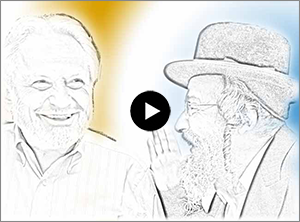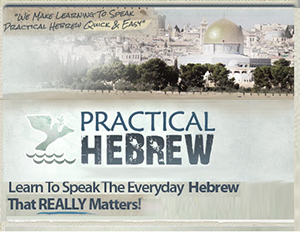Chanuka
I wish to present one small tidbit about these days of Chanuka, (some spell it Chanukah, or Hanuka).

The Gemora on Chanuka
The gemora on Chanuka in Meseches Shabbos reads, “Mitvas Chanuka Nair Eish U’Baiso …”. The basic Mitzva of lighting Chanuka lights is to light one candle each night, and that candle covers the whole household. For the Mehadrin, those who want to do better, Chazal said to light each night one candle for each of the members of the household (except for the wife, because the husband and wife are one entity).
For the Mehadrin min HaMehadrin, those who want to do the Mitzva in the best way, so according to Bais Shamai one lights eight candles the first night, and then each day you diminish one: seven, six, five, until on the last day you light one. And according to Bais Hillel on the first day you light one candle, and then increasing each day, two, three, four, until on the last day you light eight candles.
The accepted practice is to do the Mehadrin min HaMehadrin way according to Bais Hillel, one two three …
Searching for Jewish Beliefs? Click Here for my main article on Jewish Beliefs.
The gemora offers two ways of understanding the dispute between Bais Hillel and Bais Shamai. One way is that they view the days coming in or the days going out, how many days have passed or how many days are still to come. According to the other way Bais Shamai’s opinion is in line with “parei hachag”, the sacrifices which were offered in the Bais HaMikdash during the Sukkos holiday, which decreased from 13 until 7, and according to Bais Hillel “ma’alin bekodesh”, regarding matters of holiness the accepted way is to go in an upwards direction only and not downwards.
Until here I paraphrased the gemora, you should see it inside if you can.
Chanuka: Mehadrin Min HaMehadrin
I understand that the difference between the first two levels is that the basic Mitzva is an expression of thanksgiving that our household, this household, is physically and spiritually alive, because of the miracles that the A’lmighty did for us then in those days at this time. And the Mehadrin level relates to the individual, that all of these individuals in our household are alive because of those miracles.
The level of Mehadrin min HaMehadrin, apparently, is a different idea altogether, an added dimension of the remembrance of the miracle. According to the first explanation, let’s take Bais Hillel – we go from one to eight – the first night one, then two, etc. until eight. Imagine the Kohanim in the Bais HaMikdash, when they lit the first night there was a gevaltege simcha of the victory, or the finding of the oil … all of the answers to the Bais Yosef’s kasha. But on the second night (well, afternoon) when they lit with the same oil, there was an added dimension that this is the second time they are lighting with the same oil (or with the oil from the same jug). And on and on, each day it got bigger and bigger.
And Bais Shamai: When they lit the first night there was a gevaltege simcha that the Kohen was lighting the Menora with oil that is going to last now for eight days. So the next day it diminishes, the feeling is a bit smaller, that today’s lighting is going to last for another seven days, etc. This is the first approach.
The Tikun of Chanuka
I suggest to understand the gemora’s second approach as follows: That Chazal instituted the Mitzva of lighting the Chanuka candles in a way which symbolizes the “soul of the redemption” so to speak, the shoresh, the penimius, the tikun. The main point of galus really is that the Umos HaOlam control us, rule us, swallow us up. This is because we are slack in our Avodas Hashem, and we do avairos, and bring upon ourselves, draw upon ourselves, our souls, powers of the other side, of chitzonius, tumah.
And as things manifest themselves downstairs in the physical world, this expresses itself in an actual situation that we are ruled by others, swallowed up by others. When we begin to strengthen ourselves, through Torah study, through davening the way we should, through being careful with Mitzva observance, then little by little we raise the level of Kedusha and throw off the shackles of the undesirable powers, and this expresses itself in the physical world in One nation going out from another nation.
There are many stories of Tzadikim who were called to remove a dibuk who entered into someone, lo alainu. And the stories tell that besides what the Tzadik asks the dibuk what he did that he doesn’t have peace in the next world (in order to be po’el for him a tikun), he also asks him what did this person do that made him eligible for such an experience of getting a dibuk. In a similar spirit the A’lmighty in His great mercy teaches us constantly in the Torah, and constantly gives us hints how to rectify that which must be rectified in order to accomplish that which needs to be accomplished.
Bais Shamai and Bais Hillel
This is Bais Shamai and Bais Hillel. Bais Shamai says that the lighting has to be like Parei HaChag. Like the 70 parim that we offer up on Sukkos for the sake of the 70 umos haolam, yet they go in decending order, from 13 to 7, symbolizing etc. So too, when we strengthened ourselves through the inspiration of the Kohanim and threw off the shackles of the dominance of the unwholesome side of things, then the spirit of impurity on our souls became less and less, which manifested itself in becoming less and less tied up and ruled by the physical enemy. In memory of this point we light from 8 till 1.
On the flip side, Bais Hillel relates to the increasing of the side of Kedusha, like he says, “Ma’alin BaKodesh VeAin Moridin” relating to us.
The Navi says, we recite this in the Haftorah on Shabbos Chanuka, “This is the Devar Hashem to Zerubavel, lo be’chayil, ve’lo be’choach, ki eim be’ruchi …” In the spirit of the commentators on the page, Rashi and the Metzudos etc., this means that the building of the second bayis, or as it will be in the days of mashiach, that our rulership will not need to come through armies and power, etc. see there.
In a similar vein sort of, I think that as we finally pull ourselves out of the final galus, this is not going to come about through the major league players of our time, namely money and military power. Chayil in many places means wealth. How many of us at some point pictured ourselves as saving the whole world, if I only had a zillion dollars, if I only had the power of mighty armies, oh, how I would destroy evil and build goodness. This is what the navi says not to say, because the final tikun is not going to be through gelt, nor through bombs, ki eim be’ruchi, when we learn better, and daven better, and do Mitzvos better, then we will come to the tikun ha’shalaim.
Dechay Admon be’tzail tzalmon, hakaim lanu ro’eh shiv’ah. The Ro’eh of the Shiv’ah… bnei Binah yemai shemonah kavu shir ur’nanim. Binah is tshuva.
Sigh, I speak to myself, just out loud.
A lichtechen, freilechen Chanuka,
Boruch HaKohen Rappaport





Leave A Response